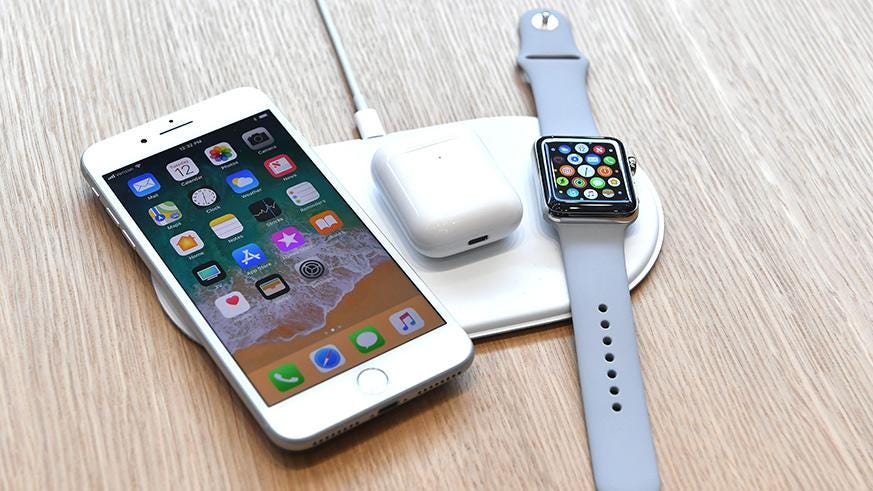4 years is (still) a long time horizon for technology
Nearly 6 years ago, I made 10 bold tech predictions for the next 10 years. Let’s check in and see how I’m doing more than halfway to the end date!
My original post for reference (4/3/2016) and my 5/11/20 update:
4 Years Later… “10 Bold Technology Predictions for the Next 10 Years”
4 years ago, I made 10 bold technology predictions for the next 10 years. Let’s see how things stand today! Author…amitch5903.medium.com
Here’s how I’m evaluating my predictions:
Achieved: Milestone has been achieved!
Probable: I believe this prediction has a >75% chance of being right
Possible: I believe this prediction has a 25–75% chance of being right
At Risk: I believe this prediction has a <25% chance of being right
May 2022 Update — Top 10 Predictions
1. Wireless Charging will be as prevalent as WiFi was in 2016

Original Theory (2016): There are over 118 million WiFi hotspots in the world today. It’s hard to not find WiFi today. In 10 years, true wireless charging, led by companies like Ossia, will have a similar penetration. No more searching for outlets, fumbling with cords, your devices will stay charged almost everywhere you go.
May 2018 Status: Possible
May 2020 Status: Possible
May 2022 Status: At Risk
May 2022 Commentary: Over the past 2 years, there hasn’t been much in the news about wireless power. While Ossia continues to plug along with promoting its “True Wireless” technologies, the company only seems to have recently secured its first OEM partnerships.
I’ve moved this prediction to “At Risk” because even if Apple or Samsung announces a phone in the next year with true wireless charging, the chance that wireless charging can achieve a WiFi level of scale worldwide is almost impossible.
I still believe wireless charging is coming, just not soon enough!
2. Tesla will be bigger than any other worldwide auto company
Original Theory (2016): Note: I did not say that Tesla will be the “biggest auto company”. I strongly believe that Tesla’s ultimate growth comes significantly more from its battery technology, charging infrastructure, and licensing opportunities than from simple auto sales.
May 2018 Status: At Risk
May 2020 Status: Probable
May 2022 Status: Achieved!
May 2022 Commentary: Well, it would be hard to be more spot-on than I was with my predictions regarding Tesla! I only wish I had bet even more on their stock 🙂
Despite the recent downturn in the market, Tesla is still sitting pretty at a $680B market cap as of 5/21/22, which is more than 3x the 2nd place carmaker, Toyota ($219B).
Tesla still makes the majority of its money from selling cars and has managed to scale impressively in volume through the pandemic, but I still believe they also have significant opportunities to scale revenue through subscriptions and licensing battery and autonomous technologies in the next decade.
3. Highway autonomous miles will exceed human-driven miles
Original Theory (2016): Led by Tesla, autonomous driving has already gone from sci-fi dream to reality. In 10 years, autonomous functionality will be so widespread that more highway miles in 2026 will be driven by computers than by humans.
May 2018 Status: Probable
May 2020 Status: Probable
May 2022 Status: Possible
May 2022 Commentary: We’re running out of time for this prediction, so I’ve moved it to “Possible.” However, several dramatic pilots have been launched or expanded in the past year:
- Cruise has launched (and quickly expanded) its full self-driving pilot in San Francisco and is now picking up real passengers!
Cruise opens driverless robotaxi service to SF public
Over the past several weeks, autonomous driving company Cruise has shared videos of its employees taking rides in…www.therobotreport.com
- Waymo expanded their long-running Phoenix pilot to downtown Phoenix
After years of focus on East Valley, Waymo expands autonomous vehicle service to downtown Phoenix
Waymo, the self-driving car company affiliated with Google, is planning to offer passenger rides in downtown Phoenix…www.azcentral.com
- Aurora has expanded their autonomous truck driving pilot with FedEx to trips of ~600 miles
Aurora expands autonomous freight pilot with FedEx in Texas
Aurora Innovation, an autonomous vehicle technology company, has expanded its self-driving freight pilot with FedEx to…techcrunch.com
Remember, my prediction is that highway autonomous miles will exceed human-driven highway miles by 2026.
With all of these pilots ramping up, plus more and more cars with autonomous features like Cadillac’s Super Cruise technology, exponential growth in autonomous miles is starting to happen.
Buckle your seatbelts, it’s going to be a fun 4 years!
4. Automobile-related fatalities will drop by at least 75%
Original Theory (2016): In 2014, 32,675 people in the US died from traffic accidents. With the proliferation of auto-braking, lane assist, autonomous driving, and other improved safety features, fatalities will drop by at least 75% by 2026.
The real question is: “Can these features get down-market fast enough to the demographics disproportionately involved in car accidents?” I think yes.
May 2018 Status: Possible
May 2020 Status: At Risk
May 2022 Status: At Risk
May 2022 Commentary: Despite all of the progress with autonomous vehicles, there are simply too many humans still driving cars (and will likely continue to be in 2026).
Also, it takes a long time for older cars to cycle out of the market and off the roads and even longer for regulations to change and for insurers to start to charge more to insure non-autonomous vehicles.
It’s unfortunately going to take longer than 4 years to reach a 75% reduction in automobile fatalities.
5. SpaceX and Blue Origin will have a combined >75% market share of the “Space Economy”
Original Theory (2016): SpaceX has the early mover advantage, but Blue Origin has been quite successful in its own right, launching and landing the same rocket three times recently. I predict that, together, these companies will command >75% market share for public and private space travel.
May 2018 Status: Probable
May 2020 Status: Probable
May 2022 Status: Achieved!
May 2022 Commentary: SpaceX, much like Tesla, has been on a roll since my post in 2020. The company is launching rockets almost every week in 2022 (with a goal of >60) and has deployed more than 2,000 Starlink satellites (!!!)
To put that in perspective, SpaceX only launched 13 times in 2019.
Did I mention they also launched 2 crewed missions and have been testing the new Starship, which has been beyond fun to watch?!
While SpaceX’s exact market share is not clear, the company was valued at >$100B in late 2021. Given all of its momentum and tangential revenue opportunities, I wouldn’t be surprised to see the company top $1T in market cap by 2026.
6. Artificial Intelligence will be largely indistinguishable from Human Intelligence
Original Theory (2016): Recently, Google’s Alpha Go trounced the #1 worldwide Go player in a highly publicized match-up. Significantly, the program didn’t rely purely on a brute force computing approach. Rather, the algorithm used machine learning and neural networks to optimize its strategy.
By 2026, artificial intelligence will have advanced so far that it will be indistinguishable from human intelligence. In many contexts, artificial intelligence will exceed that of humans, while in others, namely the creative and emotion-driven fields, it will still lag.
May 2018 Status: Probable
May 2020 Status: Probable
May 2022 Status: Probable
May 2022 Commentary: AI progress has continued to accelerate since I wrote my last update in 2020. Far from slowing down, the pandemic likely has accelerated AI research and progress. Here are some of the highlights since May 2020:
- In September 2021, AI researchers at the AI Precision Health Institute at the University of Hawaiʻi Cancer Center published two high-profile papers demonstrating for the first time that deep learning can distinguish between mammograms of women who will develop breast cancer and those who will not. Researchers showed that deep learning models performed better than models using clinical risk factors in determining screening-detected cancer risk. There are multiple AI algorithms approved by the FDA for detecting breast cancer. The best of these algorithms have a sensitivity of 82% in the detection of breast cancer, with a fixed specificity of 96.6%. Using this deep learning algorithm with a radiologist improved the sensitivity by 8%. (Source)
- In November 2021, Insilico Medicine announced that they have started the first human trial of ISM001–055, their AI-designed drug candidate for pulmonary fibrosis. This is one of the most significant milestones in the history of AI-powered drug discovery because this is the first time that a human being has been dosed with an AI-discovered novel molecule based on an AI-discovered novel target. Insilico leveraged Pharma.AI, their AI-powered drug discovery platform, to analyze over 20 disease targets to predict the most successful candidate. The company completed the entire discovery process from target discovery to preclinical candidate nomination within 18 months on a budget of $2.6 million. This is the first AI-discovered compound to enter the clinic and more compounds are expected in the near future. (Source)
- Amazon Web Services claimed to have successfully trained a machine learning model that estimates the emissions of businesses that don’t disclose their emissions (Source)
- AI company OpenAI and Microsoft collaborated to launch AI programmer Copilot in July this year. Based on OpenAI Codex, the new AI system is trained on open-source code, contextualizing a situation using docstrings, function names, preceding code, and comments to determine and generate the most relevant code. The GitHub Copilot is trained on billions of lines of public code, putting the knowledge one needs at their fingertips while saving one’s time and helping them stay focused. It works on a broad set of frameworks as well as languages including TypeScript, Ruby, Java, Go, and Python (Source)
Given the pace of research and investment in AI plus the highly visible progress of models like GPT-3, I still believe it’s probable that “In many contexts, artificial intelligence will exceed that of humans, while in others, namely the creative and emotion-driven fields, it will still lag.”
7. Virtual reality will be used as a substitute for “real” reality by a substantial portion of the US population (>5%)
Original Theory (2016): Virtual reality has taken several huge steps forward over the past few years, propelled by Oculus and the recent release of their first commercial product, Rift.
In 2026, virtual reality will be used by many (>5% of US population) as a substitute for “real” reality. Filling a similar role that television has filled over the last 60 years, VR will provide “an escape” from the difficult and often unfair nature of authentic reality.
VR Addiction will be looked at similarly to drug and alcohol addiction and will be included in the Diagnostic and Statistical Manual of Mental Disorders (DSM)
May 2018 Status: Possible
May 2020 Status: Probable
May 2022 Status: Probable
May 2022 Commentary: I’m holding this prediction at “probable.” According to research, Meta’s Quest 2 sold 8.7MM units in 2021, which amounts to almost 2x the total number of VR headsets sold in the previous year!
The cost of VR sets has come down dramatically, quality has improved substantially, and the ecosystem is scaling quickly as well.
Did I also mention that Facebook rebranded as “Meta”? The company is now fully committed to making the metaverse a reality. The markets are skeptical, but they were also very skeptical when Facebook bet the house on mobile. And we all know how that turned out…
As we saw during the pandemic, whether it was gaming, meme trading, or VR, many people were looking for different escapes from “real” reality. Even if the pandemic continues to wane, I still expect many more than 5% of people to substitute virtual reality for their “real” reality.
8. Drones will deliver >25% of all packages in the US
Original Theory (2016): 81% of the United States population lives in urban areas today. By 2026, drones will very noticeably replace the delivery truck for a substantial portion of deliveries in these areas.
Companies like UPS, FedEx, and Amazon will push as much traffic as possible to drones as they will substantially reduce costs, time to delivery, and overall environmental impact.
May 2018 Status: Possible
May 2020 Status: Possible
May 2022 Status: At Risk
May 2022 Commentary: While there are more and more companies doing delivery by drone today (whether those are ground drones or airborne ones), the tests simply haven’t scaled fast enough yet.
While I still believe we’ll reach a meaningful single digit % of deliveries by drone in 2026, it’s not going to reach 25%!
9. 3D Printing will never gain broad consumer appeal (<5% of US population will own a 3D printer in 2026)
Original Theory (2016): 3D printing will continue to grow over the next 10 years and will continue to have many commercial applications.
However, 3D printing, in any form similar to its current one, will never gain broad consumer appeal. The process is too slow, its uses are too limited, and it’s too expensive. I don’t believe it will advance quickly enough to change our lives significantly by 2026.
May 2018 Status: Probable
May 2020 Status: Probable
May 2022 Status: Probable
May 2022 Commentary: I’ll ask the same question I asked in 2020, do you know anyone who owns a 3-D printer? If so, how often do they actually use it?
I still believe 3-D printing has incredible commercial applications and even some cool educational applications, but it’s just not going mainstream. There aren’t enough practical applications for the average human to make the purchase an essential one.
It’s estimated that only about 870,000 3-D printers are operating in the U.S., according to Terry Wohlers of Wohlers Associates Inc (Source). Given the US population of ~320MM, that is about a ~.29% ownership rate.
10. At least 1 major type of cancer will be “cured”
Original Theory (2016): During the 1970s, only about 50% of people diagnosed with cancer survived >5 years. Now, more than 67% survive that long.
Today, more than 7 out of 10 children are cured of cancer. Testicular cancer, Hodgkin’s lymphoma, and many cases of leukemia can all be cured in a percentage of adults with current treatments. Most skin cancers are cured with surgery.
Through earlier diagnoses, more involved DNA/RNA expression profiling, and highly targeted treatments, at least 1 major type of cancer will be “cured” by 2026. “Cured” meaning that treatment has a 100% success rate.
May 2020 Status: Possible
May 2018 Status: Possible
May 2022 Status: Possible
May 2022 Commentary: I’m keeping this prediction “Possible.” However, despite the fact that healthcare investment increased dramatically during the pandemic, healthcare is incredibly slow-moving and cautious. 4 years to find a cure for a cancer is essentially a sprint.
I’m hoping that the combination of rapidly advancing AI drug discovery and massive increases in investment will pay off in identifying a 100% effective “cure” for at least 1 type of cancer.
What predictions do you have? Which of mine do you disagree with?
Let me know in the comments or on Twitter at @amitch5903!

